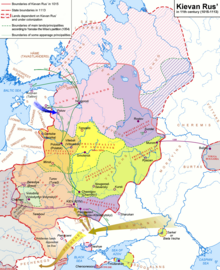
Back Чудь Bashkir Чудзь BE-X-OLD Čudové Czech Чудь CV Tschuden German Chud Spanish Tšuudid Estonian Tšuudit Finnish Tsjudar Faeroese Tchoudes French

Chud or Chude (Old East Slavic: чудь, romanized: čudǐ, Finnish: tšuudi, Northern Sami: čuhti) is a term historically applied in the early East Slavic annals to several Baltic Finnic peoples in the area of what is now Estonia, Karelia[1] and Northwestern Russia.[2] It has also been used to refer to other Finno-Ugric peoples.[3][4]
Arguably, the earliest attested written use of the word "Chuds" to describe Baltic Finnic peoples (presumably early Estonians) was c. 1100, in the earliest East Slavic chronicles.[5] According to the Primary Chronicle, the invading troops of Yaroslav I the Wise defeated "Chuds" in a battle in 1030 and then established the fort of "Yuryev" (in what is now Tartu, Estonia).
According to Old East Slavic chronicles, the Chuds were among the founders of the Rus' state.[5]
- ^ Lind, John H. (2004). "The politico-religious landscape of medieval Karelia". Fennia. 182 (1). Helsinki: 3–11.
- ^ Ryabinin, E. A. (1987). "The Chud of the Vodskaya Pyatina in the light of new discoveries" (PDF). Fennoscandia Archeologica: 87–104.
- ^ Jääts, Indrek (2009). "The Komi, Ethnic Stereotypes, and Nationalities Policy in Late Imperial Russia". The Russian Review. 68 (2): 199–220. ISSN 0036-0341.
- ^ Eliot, Charles (1911). . Encyclopædia Britannica. Vol. 10 (11th ed.). pp. 388=393.
- ^ a b Abercromby, John (1898). The Pre- and Proto-historic Finns. D. Nut. p. 13.
© MMXXIII Rich X Search. We shall prevail. All rights reserved. Rich X Search